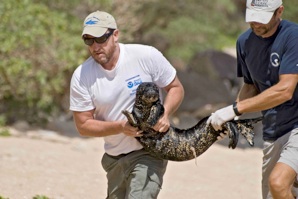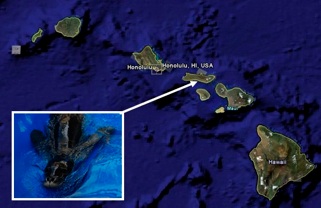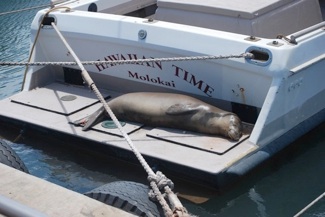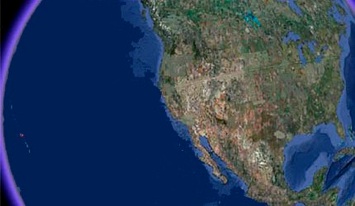Hō‘ailona’s Journey

Hō‘ailona was abandoned by his mother soon after his birth in May 2008. Rescued from a beach on the island of Kaua‘i, he was cared for by scientists from the National Atmospheric and Oceanic Administration (NOAA) and released back to the wild on the island of Moloka‘i in December 2008.
HŌ‘AILONA’S BEGINNINGS


As a newborn Hawaiian monk seal KP2 (later given the name Hō‘ailona) is rescued by David Schofield (NMFS PIRO) and Shawn Farry (NMFS PIFSC) on Kaua'i after his mom abandons him. He is so young a portion of his umbilical cord is still attached.
But Hō‘ailona did not adapt well to life in the wild. He became habituated to humans, and as a result, he began hanging out at a popular wharf and interacting with people in the water and on the beach of Moloka‘i instead of learning how to live as a wild monk seal.
As the seal grew larger, his interactions with people began to pose a risk to his health and well being, as well as to public safety. Finally, NOAA officials had to remove him from Moloka‘i. Before a new plan for returning him to the wild could be developed, veterinarians discovered that Hō‘ailona’s vision was seriously impaired; the young seal required further observation and possibly surgery.
HŌ‘AILONA’S JOURNEY


During the first year of his life Hō‘ailona traveled to four out of the eight main Hawaiian Islands (Kaua‘i, O‘ahu, and Lana‘i, and Moloka‘i). He finally settled in Kaunakakai, Moloka‘i.
Rather than sleep on a sandy beach like other monk seals, Hō‘ailona catches a snooze on the back of a boat at the public pier in Kaunakakai, Moloka‘i.

Molokai, HI
Santa Cruz, CA



In an unprecedented move, Hō‘ailona was transferred to UCSC where facilities were available for his care and for determining the best treatment for his eyes.
Currently, a team of marine mammal scientists and veterinarians are evaluating Hō‘ailona to assess his overall health and appropriate treatment plan. During his time in California Hō‘ailona is also learning to participate in scientific research that will provide data for the preservation of wild monk seals and for the identification of critical habitats in Hawaiian waters. Once he completes his treatment and rehabilitation, the plan is to return Hō‘ailona back to Hawai‘i where he can live as an important ambassador for monk seal conservation efforts worldwide.
Pacific Ocean
(Photo by T.M. Williams, NMFS Permit No. 932-1905)
(Google Earth map)
(Photo by NOAA Fisheries.)
(Photo by NOAA Fisheries)
For more information about the biology and status of the Hawaiian monk seal see the following NOAA Fisheries Pacific Island websites:
© 2010 Marine Mammal Physiology Project - University of California, Santa Cruz - All Rights Reserved
All material on this page including text, images, and video links is copyrighted to T.M. Williams and authorized under National Marine Fisheries Services Permit #932-1905/MA-009526. Permission for use can be requested at williams@biology.ucsc.edu
Site created and maintained by: Beau Richter